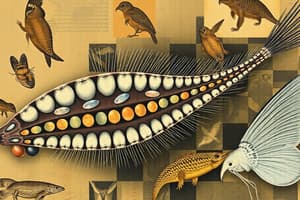Podcast
Questions and Answers
What is the typical size range of turbellarian worms?
What is the typical size range of turbellarian worms?
- 5 cm to 50 cm
- 5 mm to 5 cm
- 5 mm to 50 cm (correct)
- 50 cm to 100 cm
What is the main distinguishing feature between different turbellarians?
What is the main distinguishing feature between different turbellarians?
- The presence or absence of a gut, and the structure of the pharynx (correct)
- The size and color of the worm
- The presence or absence of suckers and hooks
- The habitat they live in (marine, freshwater, or terrestrial)
What is the main structural adaptation for parasitism in trematodes (flukes)?
What is the main structural adaptation for parasitism in trematodes (flukes)?
- Increased reproductive capacity (correct)
- Presence of an opisthaptor
- Lack of a pharynx
- All of the above
Which of the following is a key characteristic of polyclad turbellarians?
Which of the following is a key characteristic of polyclad turbellarians?
Where are trematodes (flukes) typically found as adults?
Where are trematodes (flukes) typically found as adults?
Which of the following is NOT a structural adaptation for parasitism in trematodes?
Which of the following is NOT a structural adaptation for parasitism in trematodes?
What is the key characteristic that digeneans share with ectolecithal turbellarians?
What is the key characteristic that digeneans share with ectolecithal turbellarians?
Which of the following is NOT a common vertebrate host for digenean parasites?
Which of the following is NOT a common vertebrate host for digenean parasites?
What is the significance of the name 'Clonorchis'?
What is the significance of the name 'Clonorchis'?
What is the primary host for the Schistosoma blood flukes?
What is the primary host for the Schistosoma blood flukes?
How do Paragonimus lung flukes typically infect their human hosts?
How do Paragonimus lung flukes typically infect their human hosts?
What is the significance of the term 'Bilharzia' in relation to Schistosoma infection?
What is the significance of the term 'Bilharzia' in relation to Schistosoma infection?
Flashcards are hidden until you start studying




